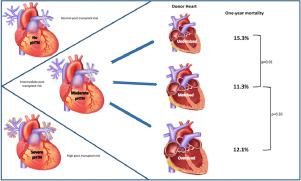The Journal of Heart and Lung Transplantation ( IF 6.4 ) Pub Date : 2020-01-31 , DOI: 10.1016/j.healun.2020.01.1339 Mahek Shah 1 , Omar Saeed 1 , Jooyoung Shin 1 , Sandhya Murthy 1 , Daniel B Sims 1 , Sasha Vukelic 1 , Daniel Goldstein 2 , Stephen J Forest 2 , Ulrich P Jorde 1 , Snehal R Patel 1

|
BACKGROUND
There is a lack of evidence to guide appropriate donor sizing in recipients with moderate pulmonary hypertension (pHTN) awaiting heart transplantation (HTx). It is common practice to oversize donor hearts for such recipients to prevent post-operative right ventricular failure. Therefore, our objective was to determine if oversizing in pre-transplant moderate pHTN provides a survival advantage.
METHODS
The United Network for Organ Sharing database was analyzed to include HTx recipients from 1994 to 2016. Recipients were considered as having moderate pHTN if the pulmonary vascular resistance (PVR) was 2.5 to 5 Wood units (WU) or transpulmonary gradient (TPG) was 10 to 18 mm Hg. Heart size mismatch was determined using the predicted heart mass equations. A size mismatch of ≥15% in either direction was considered undersized or oversized, respectively. Ninety-day and 1-year survival were analyzed based on size matching via univariate and Cox regression analysis. Propensity matching was performed to specifically evaluate the effect of donor sex among male transplant recipients.
RESULTS
Among 29,441 HTx recipients, 10,666 had moderate pHTN by PVR criteria and 12,624 HTx patients had moderate pHTN according to TPG criteria. Among patients with a PVR of 2.5 to 5 WU, oversizing was not associated with lower mortality compared with matched hearts at 90 days (7.6% vs 7.4%; p = 0.75) and 1 year (12.1% vs 11.3%; p = 0.26). Conversely, undersizing the donor was associated with a higher 90-day (10.6% vs 7.6% vs 7.4%; p < 0.01) and 1-year (15.3% vs 12.1% vs 11.3%; p < 0.01) mortality than recipients receiving oversized or matched hearts, respectively. On Cox regression analysis, there was no benefit with oversizing at 90 days (hazard ratio [HR] 0.88; p = 0.23) and 1 year (HR 0.99; p = 0.90), whereas undersizing was associated with higher 90-day (HR 1.32; p = 0.02) and 1-year mortality (HR 1.23; p = 0.03) compared to size-matched controls. Among patients with moderate pHTN based on TPG of 10 to 18 mm Hg, neither undersizing nor oversizing was predictive of mortality at 90 days and 1 year according to Cox regression analysis. Propensity matching revealed that female-to-male transplantation had similar 1-year mortality to male-to-male transplantation, and there was no advantage to oversizing female donors for male recipients.
CONCLUSIONS
In this registry-based analysis, there was no benefit to oversizing donors for cardiac transplant recipients with moderate pHTN. Elimination of this restriction could increase the donor pool and reduce wait times for such recipients.
中文翻译:

中度肺动脉高压患者中基于心脏质量的预测大小匹配:结果和性别影响。
背景
尚无证据指导等待心脏移植(HTx)的中度肺动脉高压(pHTN)接受者的合适供体大小。通常的做法是为此类接受者增大供体心脏的尺寸,以防止术后右心室衰竭。因此,我们的目标是确定在移植前适量的pHTN中过大剂量是否具有生存优势。
方法
分析了1994年至2016年的器官共享联合网络数据库,其中包括HTx受体。如果肺血管阻力(PVR)为2.5至5伍德单位(WU)或跨肺梯度(TPG)为10,则认为收件人具有中等pHTN至18毫米汞柱。使用预测的心脏质量方程式确定心脏大小失配。任一方向的尺寸不匹配率≥15%分别被认为尺寸过小或尺寸过大。基于大小匹配通过单变量和Cox回归分析来分析90天和1年生存期。进行了倾向匹配,以具体评估男性移植受者中供体性别的影响。
结果
根据PVR标准,在29,441名HTx接受者中,有10,666名具有中等pHTN,根据TPG标准,有12,624名HTx患者具有中等pHTN。在PVR为2.5至5 WU的患者中,与匹配心脏相比,在90天(7.6%vs 7.4%;p = 0.75)和1年(12.1%vs 11.3%;p = 0.26)时,过大的尺寸与较低的死亡率无相关性。。相反,供体不足的人比接受大号接受者的90天死亡率(10.6%比7.6%对7.4%;p <0.01)和1年死亡率(15.3%对12.1%对11.3%;p <0.01)高。或匹配的心。在Cox回归分析中,在90天(危险比[HR] 0.88;p = 0.23)和1年(HR 0.99;p = 0.90),而尺寸偏小 与尺寸匹配的对照组相比,则90天(HR 1.32; p = 0.02)和1年死亡率(HR 1.23; p = 0.03)高。根据Cox回归分析,在基于TPG为10至18 mm Hg的中度pHTN患者中,过小或过大均不能预测90天和1年的死亡率。倾向匹配显示,雌雄移植的一年死亡率与雄雄移植相似,并且对于男性接受者而言,女性捐赠者的规模过大没有优势。
结论
在此基于注册表的分析中,对于中等pHTN的心脏移植接受者而言,捐献者的规模过大没有任何好处。消除此限制可能会增加捐助者的数量并减少此类接收者的等待时间。











































 京公网安备 11010802027423号
京公网安备 11010802027423号